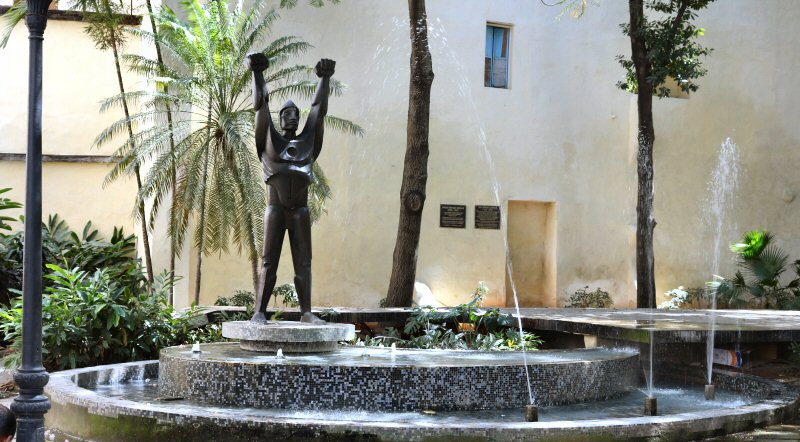
Parque Guayasamín
The Parque Guayasamín occupies the area of
a collapsed colonial building. It was inaugurated to pay tribute
to the famous Ecuadorian artist Oswaldo Guayasamín (1919-1999)
in 1995. It is one block away from the Casa Oswaldo Guayasamín.
Formerly, the park was called as Parque Rumiñahui, due to the
monumental metalwork of Guayasamín that stands in the center of
the area. The gigantic metal sculpture has an image of a robust
man with the arms raised.
Rumiñahui, the last emperor of the
Incan, was an Incan hero that faught against the invasion of the
Spanish conquistadors in Quito in the 16th century. His exploits
in the battles against the Spanish conquistadors placed General
Rumiñahui among the most famous Indian caudillos (leaders) of
the American continent, who fought for the rights of their
peoples. He was introverted, severe, strong, agile and
authoritarian, and because of his appearance he was given the
name Rumiñahui that meant Stone Eye in Quechua language. His
eyes were infusing hardness and a relentless character. Inspired
by the symbol of the indigenous resistance, the Ecuadorian
painter brought the sculpture to Cuba and presented it to the
Cuban leader Fidel Castro.
The Parque Guayasamín occupies a small
area. A few banks are scattered in the park. The sculpture of
Rumiñahui stands on one side of a two-level fountain with jets
of water. At the back of the park you will see two black
plaques, nailed on the wall. They belong to the unforgettable
Ecuadorians, Carlos Bastidas Argüello and Nela Martínez
Espinosa.
The Ecuadorian journalist Carlos Bastidas Argüello (1935-1958) played an important role in first broadcasts of Rado Rebelde despite his young age. Three days before his travel to the USA, where he planned to denounce the crimes that the Batista’s airforce committed to the rural communities, he was shot by a secret agent of Batista in a bar in Havana at the age of 23 years. Any news about the brutal murder could not be published in the press of the time due to the strict censorship.
The Ecuadorian Nela Martínez
Espinosa (1912-2004) was a tireless fighter that stimulated the
creation of multiple unions, such as the Confederation of
Workers of Ecuador and the Ecuadorian Women’s Alliance. She
strongly opposed the delivery of the Manta Military Base to the
USA. As a friend of Cuba, she received the Order of Ana
Betancourt in 1973.

The Parque Guayasamin is located on the
Mercaderes street, where it intersects with the Lamparilla
street.
